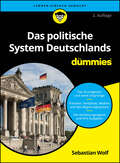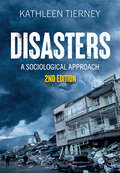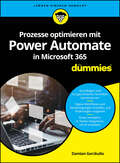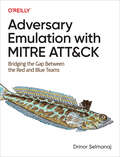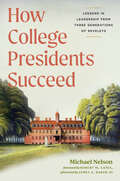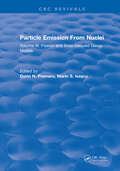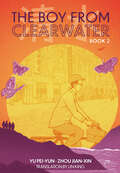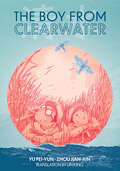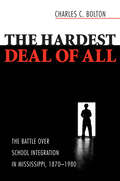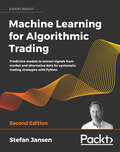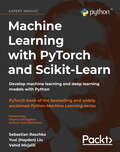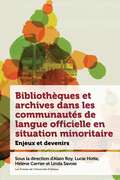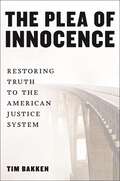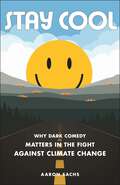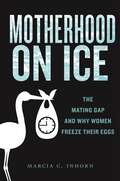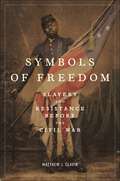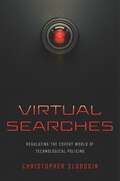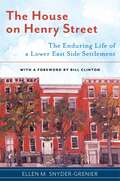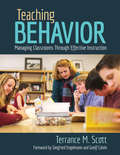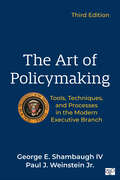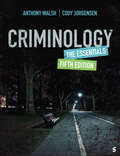- Table View
- List View
Das politische System Deutschlands für Dummies (Für Dummies)
by Sebastian WolfDie Republik auf etwas mehr als einen Blick Das politische System der Bundesrepublik ist nicht ganz einfach zu durchschauen. Was unterscheidet Vertrauensfrage und konstruktives Misstrauensvotum? Was hat es mit dem Föderalismus auf sich? Wie einflussreich sind Bundespräsident und Bundesverfassungsgericht? Ob in der Schule, der Hochschule oder einfach als interessierter Bürger, manchmal muss man unter anderem wissen, welche Aufgaben die Verfassungsorgane, Parteien und Verbände haben und wie sie zusammenwirken. Und da Deutschland fest in zwischenstaatliche Beziehungen eingebunden ist, geht der Autor auch auf internationale Einflüsse ein. Sie erfahren Welche Funktionen Bundesregierung. Bundestag, Bundesrat, Bundespräsident und Bundesverfassungsgericht haben Wie Parteien, Verbände und Medien die Politik beeinflussen Was es mit der Gewaltenteilung, den Bundesländern und der Kommunalpolitik auf sich hat
Disasters: A Sociological Approach
by Kathleen TierneyDisasters kill, maim, and generate increasingly large economic losses. But they do not wreak their damage equally across nations and populations. Every disaster has social forces at its very core. This important book sheds light on the social conditions and the global, national, and local processes that produce environmental degradation and disaster. Topics covered include the social roots of disaster vulnerability, exposure to natural hazards as a form of environmental injustice, and emerging threats. Written by a leading expert in the field, the book provides the necessary frameworks for understanding hazards and disasters, as it explores the contributions of various social science disciplines to disaster research and how these ideas have evolved over time. Bringing the social aspects of disasters to the forefront, Tierney discusses the challenge of conducting research in the aftermath of a disaster and critiques the concept of disaster resilience, which has come to be seen as a key to disaster risk reduction. This second edition places greater emphasis on climate-related disasters and offers new reflections on the impacts of Covid-19, additional material on the legacies of colonialism, and refreshed case studies. Peppered with research findings and insights from a wide range of disciplines, this rich introduction is an invaluable resource for students and scholars interested in both the social nature of disasters and their relation to broader social forces.
Prozesse optimieren mit Power Automate in Microsoft 365 für Dummies (Für Dummies)
by Damian GorzkullaWorkflows und Aufgaben auch ohne Programmierkenntnisse automatisieren! Wenn Sie häufig wiederkehrende Aufgaben oder Prozesse in einer Microsoft-365-Umgebung ohne Programmierkenntnisse automatisieren möchten, dann ist dieses Buch für Sie gemacht! Damian Gorzkulla führt Sie Schritt für Schritt und mit vielen Beispielen aus dem Berufsalltag in die Grundlagen und fortgeschrittenen Techniken dieses mächtigen Automatisierungswerkzeugs ein: von der Erstellung einfacher Flows aus Vorlagen über Genehmigungsprozesse und die Integration in Microsoft Teams bis hin zur Steuerung über die mobile Power-Automate-App oder die Einbindung von KI-Funktionalität. Sie erfahren Wie Sie Power Automate privat und im Beruf nutzen Wie Sie Power Automate und andere Microsoft-365-Anwendungen kombinieren oder integrieren Wie Sie die mobile Power-Automate-App nutzen
Adversary Emulation with MITRE ATT&CK
by Drinor SelmanajBy incorporating cyber threat intelligence, adversary emulation provides a form of cybersecurity assessment that mimics advanced persistent threat (APT) tactics, techniques, and procedures (TTPs). This comprehensive guide introduces an empirical approach with strategies and processes collected over a decade of experience in the cybersecurity field. You'll learn to assess resilience against coordinated and stealthy threat actors capable of harming an organization.Author Drinor Selmanaj demonstrates adversary emulation for offensive operators and defenders using practical examples and exercises that actively model adversary behavior. Each emulation plan includes different hands-on scenarios, such as smash-and-grab or slow-and-deliberate. This book uses the MITRE ATT&CK knowledge base as a foundation to describe and categorize TTPs based on real-world observations, and provides a common language that's standardized and accessible to everyone.You'll learn how to:Map Cyber Threat Intelligence to ATT&CKDefine Adversary Emulation goals and objectivesResearch Adversary Emulation TTPs using ATT&CK knowledge basePlan Adversary Emulation activityImplement Adversary tradecraftConduct Adversary EmulationCommunicate Adversary Emulation findingsAutomate Adversary Emulation to support repeatable testingExecute FIN6, APT3, and APT29 emulation plans
How College Presidents Succeed: Lessons in Leadership from Three Generations of Reveleys
by Michael NelsonLeadership lessons in higher education and what they can teach us about leadership in all walks of life In an era when college presidents serve for on average fewer than six years—leaving out of personal ambition for a next post or being forced to leave under fire—there is an inspirational counterexample of leaders dedicated to the long-term success of their institutions. This book weaves together the stories behind what the Washington Post dubbed &“Virginia&’s academic dynasty&” to determine what makes for sound and effective institutional leadership. Here are the lessons of three generations of college presidents from one family, the Reveleys, who have successfully led major colleges and universities across the commonwealth of Virginia for decades, an ongoing legacy unrivaled in modern American higher education. All three generations of Reveleys profiled here successfully dealt with the challenges of stewarding varied institutions—Hampden-Sydney College, William & Mary, and Longwood University—in a politically and demographically evolving state embedded within an equally dynamic and complex national, economic, and cultural environment for higher education. Now, in the Reveleys&’ own words—drawn from more than one hundred hours of oral interviews and thousands of pages of personal papers—this book tells their story and offers readers insights into best leadership practices gleaned from their unparalleled cumulative experience.
Particle Emission From Nuclei: Volume III: Fission and Beta-Delayed Decay Modes
by Dorin N. Poenaru Marin S. IvaşcuThis book has three volumes. The first volume is mainly devoted to the macroscopic-microscopic theory in its traditional form and extended to very high mass and charge asymmetry. Applications of this theory to the emission of different kinds of charged particles from nuclei are presented in the second volume, where recent experimental achievements in alpha decay, proton, and heavy ion (14C, 24Ne, 28Mg, etc.) radioactivities are also discussed. Experiments on spontaneous fission, fission isomers, and more complex phenomena like particle-accompanied fission, delayed processes: p, a, 2p, t, n, 2n, 3n, and the new mechanism of cold fission (or fission with compact shapes) are described in detail in the third volume.
The Boy From Clearwater: Book 2
by Pei-Yun YuThe "glorious" sequel to Freeman Award-winning The Boy from Clearwater After his imprisonment in Green Island, Kun-lin struggles to pick up where he left off ten years earlier. He reconnects with his childhood crush Kimiko and finds work as an editor, jumping from publisher to publisher until finally settling at an advertising company. But when manhua publishing becomes victim to censorship, and many of his friends lose their jobs, Kun-lin takes matters into his own hands. He starts a children’s magazine, Prince, for a group of unemployed artists and his old inmates who cannot find work anywhere else. Kun-lin’s life finally seems to be looking up... but how long will this last? Forty years later, Kun-lin serves as a volunteer at the White Terror Memorial Park, promoting human rights education. There, he meets Yu Pei-Yun, a young college professor who provides him with an opportunity to reminisce on his past and how he picked himself up after grappling with bankruptcy and depression. With the end of martial law, Kun-lin and other former New-Lifers felt compelled to mobilize to rehabilitate fellow White Terror victims, forcing him to face his past head-on. While navigating his changing homeland, he must conciliate all parts of himself––the victim and the savior, the patriot and the rebel, a father to the future generation and a son to the old Taiwan––before he can bury the ghosts of his past. P R A I S E ★ "Yu, Zhou, and King bear glorious witness to little-known tragic history by empathetically spotlighting an everyday superhero who survived—and thrives." –Booklist (starred) ★ "An accessible, timely account of Taiwan’s struggles for democracy and human rights as experienced through a personal lens." –Kirkus (starred) "Triumphant and rewarding." –Foreword
The Boy from Clearwater: Book 1
by Yu Pei-YunFreeman Book Award Winner GLLI Translated YA Book Prize Honoree An incredible true story in graphic novel form that lays bare the tortured and triumphant history of Taiwan, an island claimed and fought over by many countries, through the life story of a man who lived through its most turbulent times. Part One: Taiwan, 1930s. Tsai Kun-lin, an ordinary boy born in Chingshui, recounts a carefree childhood despite the Japanese occupation: growing up happily with the company of nursery rhymes and picture books on Chingshui Street. As war emerges Tsai's memories shift to military parades, air raids, and watching others face conscription into the army. It seems no one can escape. After the war, the book-loving teenager tries hard to learn Mandarin and believes he is finally stepping towards a comfortable future; but little does he know, a dark cloud awaits him ahead. Part Two: Taiwan, 1950s. In his second year at Taichung First Senior High School, Tsai is arrested simply for joining a book club and subsequently tortured, deprived of civil rights, and sent to Green Island for "reformation." Lasting until his release in September 1960, Tsai, a victim of the White Terror era, spends ten years of his youth in prison on an unjust charge. But he is ready to embrace freedom. Experience parts one and two of the tour-de-force graphic novel series that took Taiwan by storm – parts three and four coming May 2024. P R A I S E ★ "The stupendous achievements here are many: a synergistic literary success; a historic record of twentieth-century Taiwan; the remarkable account of a boy’s life; and a triumph of translation." —Booklist (starred) "A story of persistence, both hopeful and chilling, and a powerful vision of the personal implications of Taiwan’s mid-century history." —School Library Journal "Stunning." —Kirkus
The Hardest Deal of All: The Battle Over School Integration in Mississippi, 1870-1980
by Charles C. BoltonRace has shaped public education in the Magnolia State, from Reconstruction through the Carter Administration. For The Hardest Deal of All: The Battle Over School Integration in Mississippi, 1870-1980, Charles C. Bolton mines newspaper accounts, interviews, journals, archival records, legal and financial documents, and other sources to uncover the complex story of one of Mississippi’s most significant and vexing issues. This history closely examines specific events—the aftermath of the Brown v. Board of Education decision, the 1966 protests and counterdemonstrations in Grenada, and the efforts of particular organizations—and carefully considers the broader picture. Despite a “separate but equal” doctrine established in the late nineteenth century, the state’s racially divided school systems quickly developed vast differences in terms of financing, academic resources, teacher salaries, and quality of education. As one of the nation’s poorest states, Mississippi could not afford to finance one school system adequately, much less two. For much of the twentieth century, white people fought hard to preserve the dual school system, in which the maintenance of one-race schools became the most important measure of educational quality. Black people fought equally hard to end segregated schooling, realizing that their schools would remain underfunded and understaffed as long as they were not integrated.
Machine Learning for Algorithmic Trading: Predictive models to extract signals from market and alternative data for systematic trading strategies with Python, 2nd Edition
by Stefan JansenLeverage machine learning to design and back-test automated trading strategies for real-world markets using pandas, TA-Lib, scikit-learn, LightGBM, SpaCy, Gensim, TensorFlow 2, Zipline, backtrader, Alphalens, and pyfolio.Purchase of the print or Kindle book includes a free eBook in the PDF format.Key FeaturesDesign, train, and evaluate machine learning algorithms that underpin automated trading strategiesCreate a research and strategy development process to apply predictive modeling to trading decisionsLeverage NLP and deep learning to extract tradeable signals from market and alternative dataBook DescriptionThe explosive growth of digital data has boosted the demand for expertise in trading strategies that use machine learning (ML). This revised and expanded second edition enables you to build and evaluate sophisticated supervised, unsupervised, and reinforcement learning models.This book introduces end-to-end machine learning for the trading workflow, from the idea and feature engineering to model optimization, strategy design, and backtesting. It illustrates this by using examples ranging from linear models and tree-based ensembles to deep-learning techniques from cutting edge research.This edition shows how to work with market, fundamental, and alternative data, such as tick data, minute and daily bars, SEC filings, earnings call transcripts, financial news, or satellite images to generate tradeable signals. It illustrates how to engineer financial features or alpha factors that enable an ML model to predict returns from price data for US and international stocks and ETFs. It also shows how to assess the signal content of new features using Alphalens and SHAP values and includes a new appendix with over one hundred alpha factor examples.By the end, you will be proficient in translating ML model predictions into a trading strategy that operates at daily or intraday horizons, and in evaluating its performance.What you will learnLeverage market, fundamental, and alternative text and image dataResearch and evaluate alpha factors using statistics, Alphalens, and SHAP valuesImplement machine learning techniques to solve investment and trading problemsBacktest and evaluate trading strategies based on machine learning using Zipline and BacktraderOptimize portfolio risk and performance analysis using pandas, NumPy, and pyfolioCreate a pairs trading strategy based on cointegration for US equities and ETFsTrain a gradient boosting model to predict intraday returns using AlgoSeek's high-quality trades and quotes dataWho this book is forIf you are a data analyst, data scientist, Python developer, investment analyst, or portfolio manager interested in getting hands-on machine learning knowledge for trading, this book is for you. This book is for you if you want to learn how to extract value from a diverse set of data sources using machine learning to design your own systematic trading strategies.Some understanding of Python and machine learning techniques is required.
Machine Learning with PyTorch and Scikit-Learn: Develop machine learning and deep learning models with Python
by Sebastian Raschka Yuxi (Hayden) Liu Vahid MirjaliliThis book of the bestselling and widely acclaimed Python Machine Learning series is a comprehensive guide to machine and deep learning using PyTorch s simple to code framework. Purchase of the print or Kindle book includes a free eBook in PDF format.Key FeaturesLearn applied machine learning with a solid foundation in theoryClear, intuitive explanations take you deep into the theory and practice of Python machine learningFully updated and expanded to cover PyTorch, transformers, XGBoost, graph neural networks, and best practicesBook DescriptionMachine Learning with PyTorch and Scikit-Learn is a comprehensive guide to machine learning and deep learning with PyTorch. It acts as both a step-by-step tutorial and a reference you'll keep coming back to as you build your machine learning systems. Packed with clear explanations, visualizations, and examples, the book covers all the essential machine learning techniques in depth. While some books teach you only to follow instructions, with this machine learning book, we teach the principles allowing you to build models and applications for yourself. Why PyTorch? PyTorch is the Pythonic way to learn machine learning, making it easier to learn and simpler to code with. This book explains the essential parts of PyTorch and how to create models using popular libraries, such as PyTorch Lightning and PyTorch Geometric. You will also learn about generative adversarial networks (GANs) for generating new data and training intelligent agents with reinforcement learning. Finally, this new edition is expanded to cover the latest trends in deep learning, including graph neural networks and large-scale transformers used for natural language processing (NLP). This PyTorch book is your companion to machine learning with Python, whether you're a Python developer new to machine learning or want to deepen your knowledge of the latest developments.What you will learnExplore frameworks, models, and techniques for machines to learn from dataUse scikit-learn for machine learning and PyTorch for deep learningTrain machine learning classifiers on images, text, and moreBuild and train neural networks, transformers, and boosting algorithmsDiscover best practices for evaluating and tuning modelsPredict continuous target outcomes using regression analysisDig deeper into textual and social media data using sentiment analysisWho this book is forIf you have a good grasp of Python basics and want to start learning about machine learning and deep learning, then this is the book for you. This is an essential resource written for developers and data scientists who want to create practical machine learning and deep learning applications using scikit-learn and PyTorch. Before you get started with this book, you’ll need a good understanding of calculus, as well as linear algebra.
Bibliothèques et archives dans les communautés de langue officielle en situation minoritaire: Enjeux et devenir (Études canadiennes)
by Alain Roy Lucie Hotte Hélène Carrier Linda SavoieComment les bibliothèques et les archives contribuent-elles à préserver l’histoire et le patrimoine des communautés de langue officielle en situation minoritaire (CLOSM)? Cet ouvrage examine leur rôle clé dans la préservation de la mémoire collective et leur impact sur la vitalité culturelle de ces communautés. Cette analyse s’articule autour de plusieurs dimensions essentielles. Elle examine d’abord comment le patrimoine documentaire soutient la mémoire collective et met en lumière les efforts déployés par les bibliothèques et les centres d’archives pour la promouvoir et la rendre accessible. Elle s’intéresse ensuite aux politiques nécessaires pour lever les barrières linguistiques et renforcer l’accès aux ressources culturelles. Enfin, elle s’attarde à l’état et au développement des collections, en portant une attention particulière à la représentation des CLOSM.Structuré en deux grandes sections, cet ouvrage offre une riche réflexion sur les bibliothèques et leur rôle dans le soutien aux communautés linguistiques minoritaires, tout en adoptant une perspective nationale et internationale. Il explore également l’apport essentiel des archives communautaires à la vitalité des CLOSM à travers le pays, soulignant leur importance dans la préservation et le dynamisme des identités collectives.Avec son approche unique et éclairante, ce livre s’adresse à celles et ceux qui s’intéressent à la préservation du patrimoine et au rôle des institutions culturelles dans le développement des communautés linguistiques minoritaires.
The Plea of Innocence: Restoring Truth to the American Justice System
by Tim BakkenProposes groundbreaking, fundamental reform for the adversarial legal system to keep innocent people from going to prison We rely on the adversarial legal system to hold offenders accountable, ensure everyone is playing by the same rules, and keep our streets safe. Unfortunately, a grave condition lingers under the surface: at all times the imprisonment of possibly tens of thousands of innocent people. The Plea of Innocence offers a fundamental reform of the adversarial system: plausibly innocent people may now plead innocent and require the government to search for exonerating facts; in return, they will be required to waive their right to remain silent, speak to government agents, and participate in a search for truth. While almost all the participants within the system hope that only guilty people will be convicted, the unfortunate reality is that innocent people are convicted and imprisoned at an alarming rate. With the privatization of defense institutions, accused innocent people are themselves responsible for finding the facts that could exonerate them. Though the poor are represented by public defenders—in fact, almost no one who is charged with a crime has enough money to pay for a complete defense—it is still accused people, not public officials, who bear the entire burden of proving their innocence. Tim Bakken believes that reform of the three-hundred-year-old adversarial system is long overdue, and that the government should be responsible for searching for truth—exonerating facts for innocent people—rather than being satisfied with due process. While it is improbable that all the facts in any case will ever be known, the essential point is that the acquisition of facts will almost always benefit an innocent person who has been accused of a crime. Featuring compelling evidence and concrete steps for reform, The Plea of Innocence is at once sensible and revolutionary, a must-read for anyone invested in restoring truth to the justice system.
Stay Cool: Why Dark Comedy Matters in the Fight Against Climate Change
by Aaron SachsHow gallows humor can bolster us to confront global warmingWe’ve all seen the headlines: oceans rising, historic heat waves, mass extinctions, climate refugees. It feels overwhelming, like nothing can make a difference in combating this ongoing global catastrophe. How can we mobilize to save the world when we feel this depressed? Stay Cool enjoins us to laugh our way forward. Human beings have used comedy to cope with difficult realities since the beginning of recorded time—the more dismal the news, the darker the humor. Using this rich tradition of dark comedy to investigate climate change, Aaron Sachs makes the case that gallows humor, a mainstay of African Americans and Jews facing extraordinary oppression, can cultivate endurance, persistence, and solidarity in the face of calamity. Sachs surveys the macabre tradition of laughing during great suffering, from the Black Plague to the San Francisco earthquake of 1906—and offers some of the earliest examples of superlative dark comedy. He also explores how a new generation of activists and comedians are deploying dark humor to great effect, by poking fun at older people’s apathy about climate catastrophes, lambasting oil corporations’ “eco” rebranding, and even producing an off-Broadway dystopian comedy called “Sea Level Rise.” Sachs offers suggestions for how environmentalists can use dark comedy first to boost their own morale, and then to reframe their activism in more energizing and relatable ways. Environmentalism is probably the least funny social movement that’s ever existed. Stay Cool seeks to change that. Will comedy save the world? Not by itself, no. But it can put people in a decent enough mood to get them started on a rescue mission.
Motherhood on Ice: The Mating Gap and Why Women Freeze Their Eggs (Anthropologies of American Medicine: Culture, Power, and Practice #10)
by Marcia C. InhornAnswers the question: Why are women freezing their eggs?Why are women freezing their eggs in record numbers? Motherhood on Ice explores this question by drawing on the stories of more than 150 women who pursued fertility preservation technology. Moving between narratives of pain and empowerment, these nuanced personal stories reveal the complexity of women’s lives as they struggle to preserve and extend their fertility. Contrary to popular belief, egg freezing is rarely about women postponing fertility for the sake of their careers. Rather, the most-educated women are increasingly forced to delay childbearing because they face a mating gap—a lack of eligible, educated, equal partners ready for marriage and parenthood. For these women, egg freezing is a reproductive backstop, a technological attempt to bridge the gap while waiting for the right partner. But it is not an easy choice for most. Their stories reveal the extent to which it is logistically complicated, physically taxing, financially demanding, emotionally draining, and uncertain in its effects. In this powerful book, women share their reflections on their clinical encounters, as well as the immense hopes and investments they place in this high-tech fertility preservation strategy. Race, religion, and the role of men in the lives of single women pursuing this technology are also explored. A distinctly human portrait of an understudied and rapidly growing population, Motherhood on Ice examines what is at stake for women who take comfort in their frozen eggs while embarking on their quests for partnership, pregnancy, and parenting.
Symbols of Freedom: Slavery and Resistance Before the Civil War
by Matthew J. ClavinHow American symbols inspired enslaved people and their allies to fight for true freedomIn the early United States, anthems, flags, holidays, monuments, and memorials were powerful symbols of an American identity that helped unify a divided people. A language of freedom played a similar role in shaping the new nation. The Declaration of Independence’s assertion “that all men are created equal,” Patrick Henry’s cry of “Give me liberty, or give me death!,” and Francis Scott Key’s “star-spangled banner” waving over “the land of the free and the home of the brave,” were anthemic celebrations of a newly free people. Resonating across the country, they encouraged the creation of a republic where the right to “life, liberty, and the pursuit of happiness” was universal, natural, and inalienable.For enslaved people and their allies, the language and symbols that served as national touchstones made a mockery of freedom. Deriding the ideas that infused the republic’s founding, they encouraged an empty American culture that accepted the abstract notion of equality rather than the concrete idea. Yet, as award-winning author Matthew J. Clavin reveals, it was these powerful expressions of American nationalism that inspired forceful and even violent resistance to slavery.Symbols of Freedom is the surprising story of how enslaved people and their allies drew inspiration from the language and symbols of American freedom. Interpreting patriotic words, phrases, and iconography literally, they embraced a revolutionary nationalism that not only justified but generated open opposition. Mindful and proud that theirs was a nation born in blood, these disparate patriots fought to fulfill the republic’s promise by waging war against slavery.In a time when the US flag, the Fourth of July, and historical sites have never been more contested, this book reminds us that symbols are living artifacts whose power is derived from the meaning with which we imbue them.
Virtual Searches: Regulating the Covert World of Technological Policing
by Christopher SloboginChoice Outstanding Academic Title 2023A close look at innovations in policing and the law that should govern themA host of technologies—among them digital cameras, drones, facial recognition devices, night-vision binoculars, automated license plate readers, GPS, geofencing, DNA matching, datamining, and artificial intelligence—have enabled police to carry out much of their work without leaving the office or squad car, in ways that do not easily fit the traditional physical search and seizure model envisioned by the framers of the Constitution. Virtual Searches develops a useful typology for sorting through this bewildering array of old, new, and soon-to-arrive policing techniques. It then lays out a framework for regulating their use that expands the Fourth Amendment’s privacy protections without blindly imposing its warrant requirement, and that prioritizes democratic over judicial policymaking. The coherent regulatory regime developed in Virtual Searches ensures that police are held accountable for their use of technology without denying them the increased efficiency it provides in their efforts to protect the public. Whether policing agencies are pursuing an identified suspect, constructing profiles of likely perpetrators, trying to find matches with crime scene evidence, collecting data to help with these tasks, or using private companies to do so, Virtual Searches provides a template for ensuring their actions are constitutionally legitimate and responsive to the polity.
The House on Henry Street: The Enduring Life of a Lower East Side Settlement (Washington Mews Books #7)
by Ellen M. Snyder-GrenierChronicles the sweeping history of the storied Henry Street Settlement and its enduring vision of a more just societyOn a cold March day in 1893, 26-year-old nurse Lillian Wald rushed through the poverty-stricken streets of New York’s Lower East Side to a squalid bedroom where a young mother lay dying—abandoned by her doctor because she could not pay his fee. The misery in the room and the walk to reach it inspired Wald to establish Henry Street Settlement, which would become one of the most influential social welfare organizations in American history.Through personal narratives, vivid images, and previously untold stories, Ellen M. Snyder-Grenier chronicles Henry Street’s sweeping history from 1893 to today. From the fights for public health and immigrants’ rights that fueled its founding, to advocating for relief during the Great Depression, all the way to tackling homelessness and AIDS in the 1980s, and into today—Henry Street has been a champion for social justice. Its powerful narrative illuminates larger stories about poverty, and who is “worthy” of help; immigration and migration, and who is welcomed; human rights, and whose voice is heard.For over 125 years, Henry Street Settlement has survived in a changing city and nation because of its ability to change with the times; because of the ingenuity of its guiding principle—that by bridging divides of class, culture, and race we could create a more equitable world; and because of the persistence of poverty, racism, and income disparity that it has pledged to confront. This makes the story of Henry Street as relevant today as it was more than a century ago. The House on Henry Street is not just about the challenges of overcoming hardship, but about the best possibilities of urban life and the hope and ambition it takes to achieve them.
Teaching Behavior: Managing Classrooms Through Effective Instruction
by Terrance M. ScottThe key to effective classroom management starts with instruction Every teacher knows that the perfect lesson plan is useless without effective classroom management. But what’s the best way to foster student engagement, differentiate instruction, handle disruptive students, and promote positive behavior? The answer is in how you teach. Teaching Behavior goes well beyond setting classroom rules, communicating consequences, and providing the usual tips on engaging students and building relationships. It draws on the most current evidence-based practices and rich, real-world examples to get to the heart of effective teaching. A national expert in behavior and special education, Terry Scott shares clear, detailed and proven instructional strategies to maximize student success. Teaching Behavior is ideal as a teacher guide or textbook, offering New insights on why instruction is the foundation for all student behavior Practical tools for managing all types of students and classrooms, including the most challenging Self-assessment checklists and discussion questions for teacher book-study groups Wherever you are in your teaching career, Teaching Behavior will give you the innovative, day-to-day tools to conquer the toughest behavior challenges and make your classroom more effective and fun — for you and your students. "Terry Scott provides numerous suggestions for educators who want to teach students ways to address their behavior in order to have a positive impact not only on the students’ conduct but ultimately on their academic success." Marcia B. Imbeau, Ph.D., Professor University of Arkansas "Classroom management is, was, and always will be, of concern to educations. Teaching Behavior is a great springboard for focused dialogue between experienced and beginning teachers on this topic." Sandra Moore, ELA Teacher Coupeville High School
The Art of Policymaking: Tools, Techniques, and Processes in the Modern Executive Branch
by George Shambaugh Paul J. WeinsteinThe Art of Policymaking is the only book designed to provide students and practitioners with a detailed explanation of the specific tools, techniques, and processes used to create policy in the U.S., as well as the tools they need to understand them. The book includes practical advice on how to write memos, prepare polling questions, and navigate the clearance process. Case studies show how actual policies were developed and how and why policies and processes differed across administrations. And scenarios allow students to practice the tools and techniques they have learned by working through both domestic and foreign policy situations. Written by two experts in the field with experience in both academia and government, The Art of Policymaking is the perfect how-to guide for students and professionals.
Criminology: The Essentials
by Anthony Walsh Cody JorgensenIn Criminology: The Essentials, authors Anthony Walsh and Cody Jorgensen introduce students to major theoretical perspectives and criminology topics in a concise, easy-to-read format. This straightforward overview of the major subject areas in criminology thoroughly covers the most up-to-date advances in theory and research, while challenging students to consider the applications of these theories as well as their policy implications. Updates to the Fifth Edition include new topics and developments in criminology, such as racial disparities in arrest rates, insights from the Big Five personality traits, cognitive behavioral therapy, gun violence and policy, and the opioid epidemic. It also offers detailed evaluations of theories to deepen student understanding and foster engaging classroom discussions.
Criminology: The Essentials
by Anthony Walsh Cody JorgensenIn Criminology: The Essentials, authors Anthony Walsh and Cody Jorgensen introduce students to major theoretical perspectives and criminology topics in a concise, easy-to-read format. This straightforward overview of the major subject areas in criminology thoroughly covers the most up-to-date advances in theory and research, while challenging students to consider the applications of these theories as well as their policy implications. Updates to the Fifth Edition include new topics and developments in criminology, such as racial disparities in arrest rates, insights from the Big Five personality traits, cognitive behavioral therapy, gun violence and policy, and the opioid epidemic. It also offers detailed evaluations of theories to deepen student understanding and foster engaging classroom discussions.
